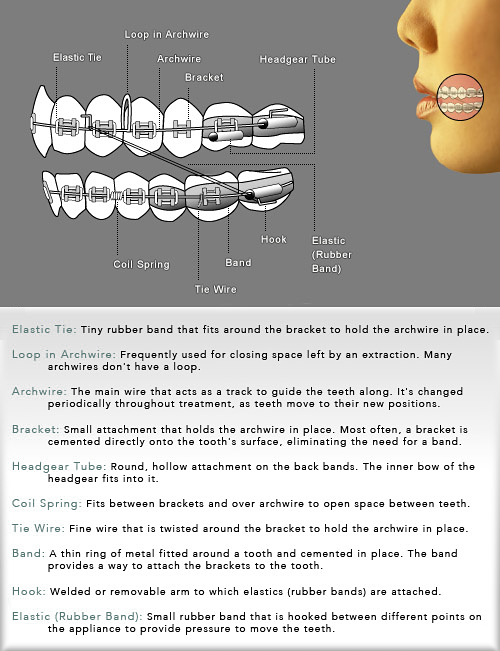Orthodontic Terms & Classifications

ARCH WIRE
The part of your braces that moves the teeth. The arch wire is attached to the brackets by small elastic donuts or ligature wires. Arch wires are changed throughout the treatment. Each change brings you closer to the ideal tooth position.
BRACKETS
Brackets are the “braces” or small attachments that are bonded directly to the tooth surface. The brackets are the part of your braces to which the dentist or assistant attaches the arch wire.
Occasionally, a bracket may come loose and become an irritation to your mouth. You can remove the loose bracket (see orthodontic emergencies section) and save it in an envelope to bring to the office. Call the office as soon as possible and make an appointment to re-glue the bracket.
ELASTICS (RUBBER BANDS)
At some time during treatment, it may be necessary to wear elastics to coordinate the upper and lower teeth and perfect the bite. Once teeth begin to move in response to elastics, they move rapidly and comfortably. Your elastics should be worn at all times or as instructed by your orthodontists. They can be removed during meals and when you brush and floss, but you should replace them as soon as you finish. Your orthodontist will give you plenty of replacements. Change elastics as directed, usually once or twice a day.
O RINGS/A-tie
O rings, also called A-ties, are little rings used to attach the arch wire to the brackets. These rings come in standard gray or clear, but also come in a wide variety of colors to make braces more fun. A-ties are changed at every appointment to maintain good attachment of the arch wire to the bracket, enabling our patients to enjoy many different color schemes throughout treatment.
SEPARATOR
A plastic or rubber donut piece which the dentist uses to create space between your teeth for bands (picture of this)
OCCLUSION
The alignment and spacing of your upper and lower jaw/teeth when you bite down.
MALOCCLUSION
Poor positioning of the teeth.
Orthodontic Classifications:
Class I-The upper and lower jaws align properly. (picture)
Class II-The upper jaw/teeth stick out past the lower teeth. (add picture)
Class III-The lower jaw/teeth stick out past the upper teeth. This is also called an “underbite.”
Open bite – Opening/space between upper and lower teeth front teeth when the back teeth are closed.
Overbite -vertical overlapping of the upper front teeth over the lower front teeth.
Overjet - Horizontal projection of the upper front teeth beyond the lower front teeth.
Crossbite - When top teeth bite inside the lower teeth. It can occur with the front teeth or back teeth.
Orthodontic Fixed and Removable Appliances:
Herbst
An appliance designed to encourage the lower jaw to grow forward and “catch up” to upper jaw growth.
Lower Lingual Holding Arch (LLHA)
A lower lingual holding arch is a space maintainer for the lower jaw. It prevents the molars from migrating forward and subsequently blocking the space of teeth that develop and erupt later. This appliance is fabricated by placing bands on the molars and connecting them to a wire that fits up against the inside of the lower teeth. Lower lingual holding arches are often placed as a retainer in the lower jaw after Phase 1 orthodontic treatment. They are also necessary when several baby teeth are lost early due to cavities or other factors.
Palatal Expander
An appliance that widens a patient’s upper (maxillary) arch or jaw. It is placed on the roof of the mouth and is typically worn for at least 6 months. The expander applies gradual pressure, via an adjustable expansion screw to move the upper jaw bones apart at the connection point or suture of the jaw. Once in place the expander is adjusted at home by an adult, according to a schedule that we develop. This result of the expansion creates a wider palate allowing teeth and jaws to more properly align and function.
Quad Helix
A quad helix is an appliance that is used to expand or widen the upper (maxillary) arch or jaw. This expander is typically used for patients in Phase I orthodontic treatment, to correct crowding and crossbites. After the appliance is inserted, it will gradually widen the arch with gentle pressure and small activation adjustments the doctor will make at orthodontic appointments.
Nance
The Nance appliance is a space maintainer/fixed retainer for the upper jaw. It prevents the molars from migrating forward and subsequently blocking the space of teeth that develop and erupt later. It consists of bands anchored around the upper molars, which are connected to a plastic button which rests on the palate. It is typically used as a retainer during orthodontic treatment phases, or due to early loss of baby teeth.
Retainers:
At the completion of the active phase of orthodontic treatment, braces are removed and removable/fixed appliances called retainers are delivered. To retain means to hold. Teeth must be retained or held in their new positions while the tissues, meaning the bone, elastic membranes around the roots, the gums, tongue and lips have adapted themselves to the new tooth positions. Teeth can move if they are not retained. It is extremely important to wear your retainers as directed!
Hawley Retainer
A universally used removable retainer. This retainer has many applications; to move teeth, close spaces, but most commonly used to maintain alignment during or after treatment.
Bonded Retainer
A bonded retainer consists of a thin metal wire, attached by composite material to the back of the teeth to secure them and prevent shifting.
